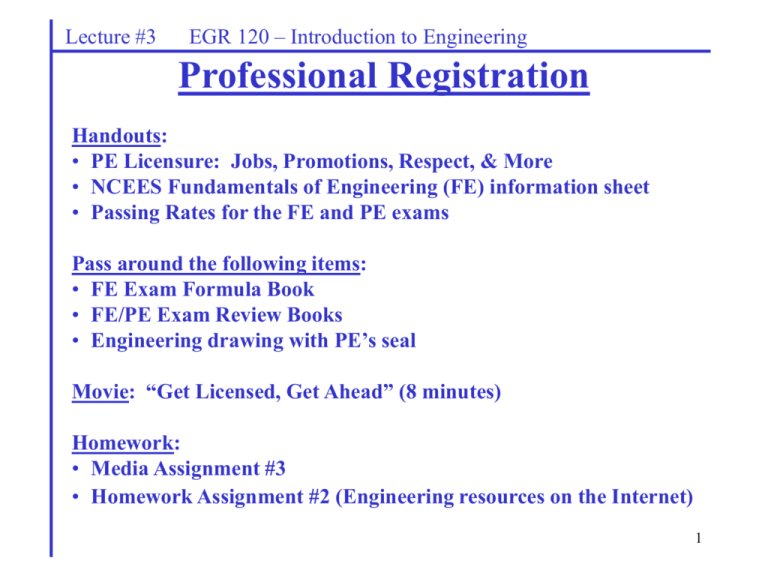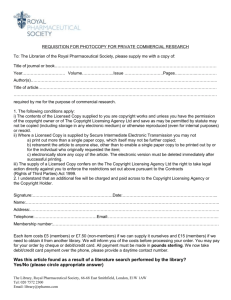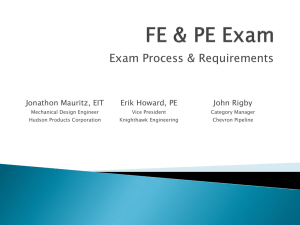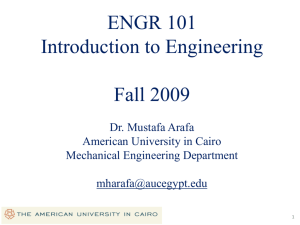Licensed Professional Engineers
advertisement

Lecture #3 EGR 120 – Introduction to Engineering Professional Registration Handouts: • PE Licensure: Jobs, Promotions, Respect, & More • NCEES Fundamentals of Engineering (FE) information sheet • Passing Rates for the FE and PE exams Pass around the following items: • FE Exam Formula Book • FE/PE Exam Review Books • Engineering drawing with PE’s seal Movie: “Get Licensed, Get Ahead” (8 minutes) Homework: • Media Assignment #3 • Homework Assignment #2 (Engineering resources on the Internet) 1 Lecture #3 EGR 120 – Introduction to Engineering Professional Registration Many practicing engineers are registered as licensed Professional Engineers (PE’s). The licensing of engineers is somewhat similar to the licensing of doctors and lawyers. A lawyer cannot practice without passing the BAR exam. Similarly, in some areas of engineering, engineers are required to be licensed in order to work. While many areas of engineering do not require licensing, it is wise for all engineers to consider becoming licensed. Just as a doctor might sign his name as John Q. Doe, MD a licensed Professional Engineer would sign his name as John Q. Doe, PE an the engineer could seal engineering drawings as illustrated below. PE Seal 2’-3 John Doe Engineering Engineers•Surveyors •Planners Landscape Architects •Environmental Consultants Virginia Beach, Virginia 2 Lecture #3 EGR 120 – Introduction to Engineering Why become registered as a Professional Engineer (PE)? 1. Licensing is required in many areas of engineering Civil engineers usually need to licensed Engineers working for local, state, or federal governments often need to be licensed The drawings associated with building projects must be “sealed” by a licensed engineer Many engineering companies consider licensing to be important 2. Licensing may be required or helpful for promotions The head of a given engineering project can seal the drawings done under his supervision, so an unlicensed engineer may not be able to advance into a position of more responsibility Licensing is an important factor in promotions Many companies advertise the number of licensed engineers that they have on staff National statistics show that licensed engineers earn higher salaries than unlicensed engineers 3 Lecture #3 EGR 120 – Introduction to Engineering 3. Licensing is a sign of competence The licensing process is well recognized and highly regarded Being licensed is an excellent item to add to your resume 4. Licensing is required to own your own consulting business You may wish to start your own engineering company in the future 5. Licensing is required to testify as an “expert witness” in court You have probably seen TV shows where a doctor testified as to the cause of death in a trial. Would the court have recognized someone as an expert witness who was a nurse, medical technician, or a layman with lots of medical experience? No. A licensed medical doctor (MD) is required to be an expert witness on medical matters. Similarly, suppose there is a lawsuit over some engineering services provided or some liability involving an engineering product. Who would the court turn to for accurate testimony of technical information? Licensed Professional Engineers. 4 Lecture #3 EGR 120 – Introduction to Engineering 6. You never know when you may need to be licensed The licensing process involves tests that are easier to take near graduation with an engineering degree while the coursework is still fresh. It is difficult to be tested on a wide range of engineering subjects years after graduation. You may wish to open your own business later. You may decide to work for a city or state government after many years in the private sector 5 Lecture #3 EGR 120 – Introduction to Engineering Steps in becoming licensed as a Professional Engineer (PE) 1. Graduate with a BS Engineering degree from an ABET-accredited program • This is an important point to consider when selecting an engineering college and program. 2. Pass the Fundamentals of Engineering (FE) Exam • This exam used to be called the Engineer-In-Training (EIT) exam. • Engineers can take the exam during their senior year (highly recommended). 3. 4 years of qualified work experience are required • The experience could be prior to graduation or the exams. • The state decides what experience is valid during the application process. • Up to two years of graduate study in Engineering can apply. • 6 years experience are required in Virginia with a BSET (BS in Engineering Technology) degree from an ABET-accredited program (may vary by state). 4. Pass the Principles and Practice of Engineering (PE) Exam • This is the last step before becoming a licensed PE, so the exam is often 6 referred to as the PE Exam. Lecture #3 EGR 120 – Introduction to Engineering Licensure is controlled by the state • Each state licenses Professional Engineers • All states use the same exams, but requirements such as experience needed may vary. The exams are written by the National Council of Examiners for Engineering and Surveying (NCEES). • The PE license is good for life as long as fees are paid (perhaps $40/yr or so) and the license is not suspended or revoked as a disciplinary action. • If an engineer works in several states, he or she must obtain a license in each state. This is usually a simply process (no further testing), but will definitely require paying fees to each state. • Why is the state involved? Primarily to protect the public. They insure that legal and ethical practices are followed in the engineering profession. If engineers violate any regulations, they can be fined by the state and/or have their licenses suspended or revoked. A common violation is for an engineer to seal a drawing for work that was not done by the engineer or under his or her direct supervision (see Section 2b under Rules of Practice in the NSPE Code of Ethics). 7 Lecture #3 EGR 120 – Introduction to Engineering The Fundamentals of Engineering (FE) Exam This is a very broad exam, covering a wide range of topics generally encountered in the first three years of an Engineering program. It is recommended that engineering students take the exam during their senior year. The FE Exam has two parts: 4-hour morning session: 120 problems, general engineering topics including math, chemistry, computers, statics, dynamics, material science, electric circuits, mechanics of materials, thermodynamics, fluid mechanics, engineering economics, and ethics. For more information, visit www.ncees.org and follow links to FE Exam Morning Specifications. 4-hour afternoon session: 60 problems, choose 1 of 7 disciplines: chemical, civil, industrial, electrical, environmental, mechanical, or general engineering. For more information, visit www.ncees.org and follow links to FE Exam Afternoon Specifications. 8 Lecture #3 EGR 120 – Introduction to Engineering The Fundamentals of Engineering (FE) Exam (continued) Typically 70% is needed to pass although a curve is sometimes used. The FE Exam is offered every April and October. Review courses are available and some colleges (such as ODU) include a required review course during the senior year. No books are allowed during the exam except the official FE Handbook. This is essentially a formula book (about 150 pages) on various topics in Engineering. For more information, visit www.ncees.org and follow links to Study Materials and FE Handbook. Calculators - discuss restrictions in class Passing rate statistics are available from www.ppi2pass.com (or see handout provided in class). 9 Lecture #3 EGR 120 – Introduction to Engineering The Principles and Practices of Engineering (PE) Exam This is a discipline-specific exam. Disciplines include: Chemical Civil Electrical Environmental Mechanical Structural I Structural II Agricultural Control Systems Fire Protection Industrial Manufacturing Metallurgical Mining/Mineral Petroleum Nuclear. 10 Lecture #3 EGR 120 – Introduction to Engineering The Principles and Practices of Engineering (PE) Exam (continued) The first three steps in the process of becoming licensed must be completed first. The PE Exam has two parts: 4-hour morning session: Breadth Exam. Questions deal with a wide selection of topics within the discipline. The intent is to insure that the engineer has a basic knowledge of most areas within the given discipline. Work 40 out of 40 problems. Multiple-choice format. For more information, visit www.ncees.org and follow links to PE Exam Specifications. 4-hour afternoon session: Depth Exam. The examinee picks one out of several choices of specialized topics within the discipline. The list of topics can be found a www.ncees.org. The intent is to test the engineer one some area of specialization. Work 40 out of 40 problems. Multiple-choice format. For more information, visit www.ncees.org and follow links to PE Exam Specifications. 11 Lecture #3 EGR 120 – Introduction to Engineering The Principles and Practices of Engineering (PE) Exam (continued) Typically 70% is needed to pass although a curve is sometimes used. The PE Exam is offered every April and October (some disciplines only in October). Review courses are available. Books and bound notebooks are allowed and are very important. Save your engineering books! Calculators - discuss restrictions in class Passing rate statistics are available from www.ppi2pass.com (or see handout provided in class). 12



